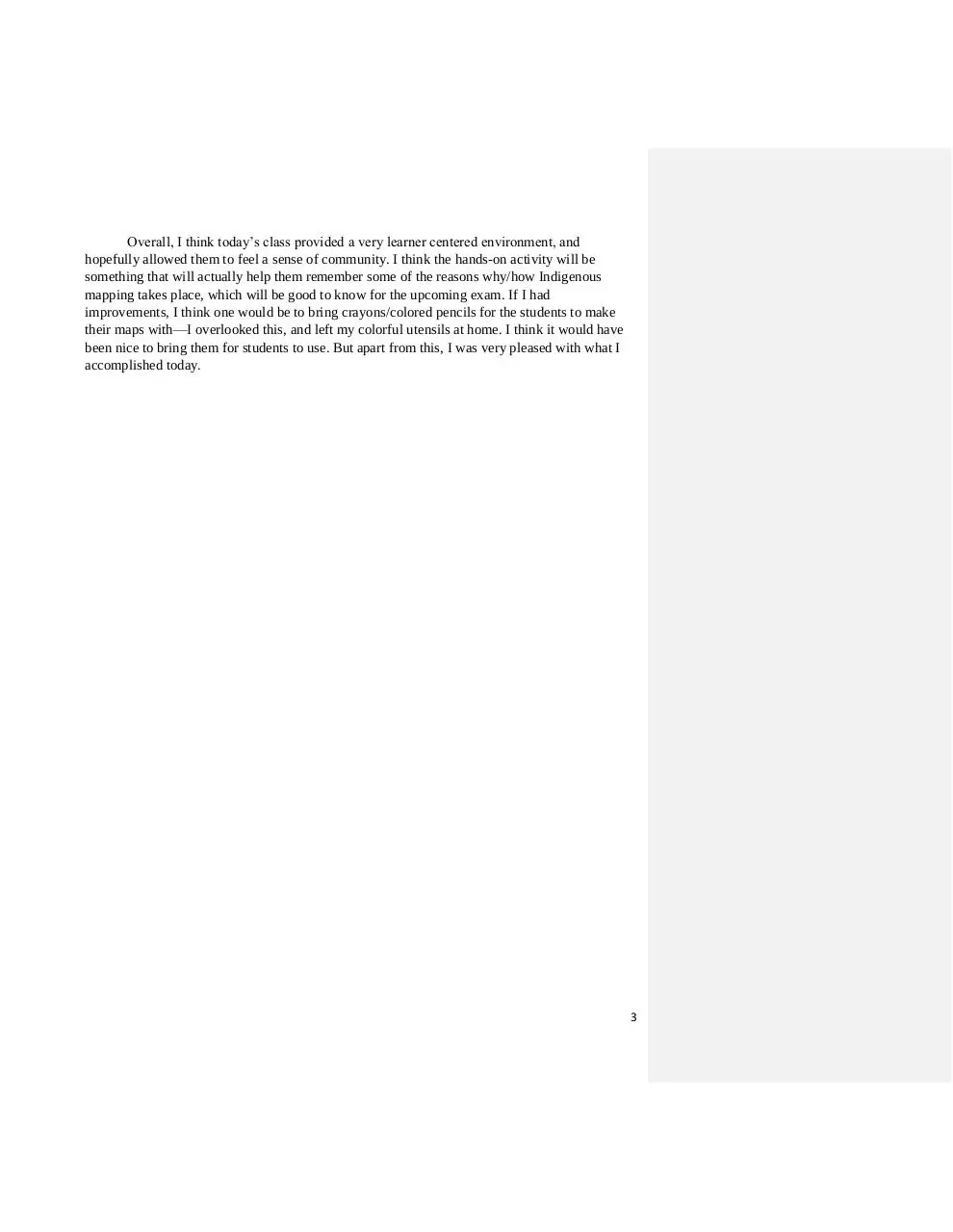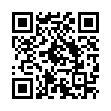March25 Mascha (PDF)
File information
Author: Boyer, Michelle
This PDF 1.5 document has been generated by Microsoft® Word 2016, and has been sent on pdf-archive.com on 02/05/2016 at 21:28, from IP address 150.135.x.x.
The current document download page has been viewed 359 times.
File size: 186.78 KB (3 pages).
Privacy: public file



File preview
Michelle Nicole Boyer-Kelly
March 25, 2016
Teaching Self-Reflection
Date: Friday, March 25th, 2016 from 10-10:50am
Course: AIS 160A – Many Nations of North America
Room: Cesar Chavez 306
Students in Attendance: 22 students (of 26 regular)
Today, I began class promptly at 10am, even though a few students filtered in a few
minutes late. I have noticed that the later we get in the semester, the more students I have that for
some reason are late to class. However, since it does not seem to be the same group of students, I
have only mentioned (via email) for students to try to be prompt to class.
My first goal of today’s session was to pass back the “pop quiz” sheets from
Wednesday’s lecture. Students watched a movie and were told to take notes during the film,
which they then turned in as a pop quiz grade. In this course, we typically do not give any forms
of quizzes back, but because these were actually notes we had to make sure the students received
them. For this quiz, I only put check marks on the top of the page to verify that I had received it,
so the quickest way to get these items back was to have students pass them around the room. In
hindsight, I should have alphabetized them so that students could find their notes quicker, but
this slipped my mind during the grading process.
While students were passing the notes back, I was able to provide immediate feedback on
the essay outlines that were due at 9am (an hour before our class). I made feedback that I felt was
broad, and showed issues that lots of students had including, but not limited to: not using
Wikipedia as a source, making sure to include a book/journal source and not just online sources,
to pay attention to “contemporary” issues after 1970, etc. While students will be receiving direct
feedback from me this weekend, I had already done an initial scan of everything that was turned
in so that I could guide them immediately with some of these wide scale issues. Also, I
mentioned that the following Friday would be the Exam 2 Review, so that students could make
sure to come to class this day.
Once all the notes were passed out, I had students break into groups to discuss the film. I
liked that students were able to try and make actual circles or squares with the chairs in the room.
There were still a few students that did not move much, but at least they made the effort. I
noticed that, as usual, there were a few students that were not participating much in the
discussion. However, these are the students that did not come to the lecture to watch the in-class
film. I intentionally allowed them to be put into random groups, because as an educator I do not
want them to go into the upcoming Exam 2 without having ever heard anything about the film.
They will likely not have received all of the details of the film in their group, but I want them to
have some knowledge, and that knowledge can come from what those in the group discussed.
1
Commented [MNG1]: Such immediate feedback is very
effective. Once you have completed the grading over the
weekend, you could also consider using VideoNote in D2L to
record some more general feedback to your students. That
way, your remarks reach them fast, before the next class
meeting. Moreover, increasing numbers of studies show
that students react very positively to feedback on their
writing that is given “personally” in a video or audio
recording. It contributes to the feeling of tutoring and caring
and is less likely perceived as negative critique. Students
feel less vulnerable and are more open to engage with the
advice.
Commented [MNG2]: The group-based spatial
arrangement worked well. Most groups seemed to be on
target. The group of 5 at the front left did particularly well
with their discussion. Two students sitting in the back center
did not move to join groups and appeared disengaged.
I then asked students to tell me what they had mentioned in their groups as important
notes. I was pleasantly surprised, because the students were able to touch upon a lot of key points
from the film. For me, I think this means they actually were engaged with the film that was
chosen by the teaching team, and paid a bit more attention to it than they regularly do. After
students brought up their points, I went through some of my notes from the film and tried to
clarify things about the film that they will encounter on the exam.
As an activity, I think this group work went over very well. I was happy with the amount
of discussion that took place. It seems that the more group work I do, the more engaged the
students are and the more willing they are to talk in groups. Unlike my regular groups of 2-3, I
also told them to create groups of 4-5, and this may have helped a bit, because they have a few
extra group members to rely upon.
The second activity connected students to a mapping activity. In class, Dr. Colombi had
discussed his work with a Google Mapping project in Indigenous Russia, and during that lecture
on Monday I was watching student reactions to the material. It seemed like the professor skipped
over the “why” of the project—why is it important for the Indigenous communities of Russia to
create maps—and the “how” of the project—how does this look or appear? He did show one or
two maps, but really did not discuss them in depth. I saw that students seemed to become
disengaged with the material (they began texting, browsing the internet, a few actually got up
and left) and so I wanted to address this. Rather than just re-discuss what mapping was, I wanted
to have students get a hands-on experience.
First, I printed out a map of my farm out in southwest Tucson and then spent a quick 10
minutes at home creating my own Indigenous themed map. I showed students the real Google
map of this location to show them what we think of when we currently think of Google maps. I
then showed them my own map, which was very different. I explained to them that my map has
things on it that are known only to me, or people I grew up with. Though a little different, this is
similar to the Indigenous maps being created—they provide special insight and information to
areas. I wanted to show my own example so that students had an idea of how I was connecting
this activity to the course information. It also seemed fair to have done the assignment/activity
that I was going to assign them, so that I could gauge how much time to give it.
Commented [MNG3]: Some of the students spoke in full
sentences and added elaboration. Others mentioned only
keywords – maybe ask them to elaborate as well because
uttering a keyword and letting the instructor elaborate on it
does not demonstrate learning.
Commented [MNG4]: You elaborated on your own notes
about the movie based on what may be on the exam; the
discussion was mostly about what will be on the exam…
what impression does that leave in regards to the relevance
and applicability of the material?
Addition: Thank you for clarifying the situational factors in
our conversation! In this case, transparency about the exam
remedied students’ anxiety about the fact that they are not
able to retrospectively access the film. Without the anxiety,
the students could relax and focus on the learning and
content of the review.
Commented [MNG5]: Thank you for clarifying in our
conversation how the students related the course content
to the exercise; it was not yet apparent in the observed
session, but obviously became very clear during the exam
review the following week. For your portfolio, you might
relate the experience with your one student who later
talked with you about her desire not to share certain
geographic information on her map as an afterthought to
her submission – her making the connection between her
own desire for privacy of some information and the desire
of a tribal nation to not relate all significant places was an
important learning moment.
I brought in some paper and had students, still in groups, to give them a continued sense
of community (we’re all doing this assignment together, not alone in our own chair) began
drawing and creating their own Indigenous map. I think allowing a good 7-10 minutes was
needed, and it really let students think about what was important for their map. I then had one
volunteer to show his map, which was fun and interactive for the class. I then randomly selected
two other students to share when no one stepped up to do so—which is typical in this section of
my course. They are very shy about showing, discussing, etc., because they seem to be in other
fields (sciences, math, economics, etc.) where there are either right/wrong answers and they do
not want to be “Wrong” in front of their peers. I am trying to train them to be more relaxed and
not to fear being “wrong” in my class, but that is taking far more time than I thought it would.
Commented [MNG6]: It is very motivating for students to
see that an instructor partook in a certain task; it alleviates
the fear of being assigned “busy work.”
Commented [MNG7]: It is hard to explain to students of
one discipline (say, hard sciences) how scholarly work is
done in another discipline (say, Social Sciences). In this case,
how can you indicate to the students that conversation,
discussion, and negotiation are core elements of the work
of your field?
2
Overall, I think today’s class provided a very learner centered environment, and
hopefully allowed them to feel a sense of community. I think the hands-on activity will be
something that will actually help them remember some of the reasons why/how Indigenous
mapping takes place, which will be good to know for the upcoming exam. If I had
improvements, I think one would be to bring crayons/colored pencils for the students to make
their maps with—I overlooked this, and left my colorful utensils at home. I think it would have
been nice to bring them for students to use. But apart from this, I was very pleased with what I
accomplished today.
3
Download March25 Mascha
March25_Mascha.pdf (PDF, 186.78 KB)
Download PDF
Share this file on social networks
Link to this page
Permanent link
Use the permanent link to the download page to share your document on Facebook, Twitter, LinkedIn, or directly with a contact by e-Mail, Messenger, Whatsapp, Line..
Short link
Use the short link to share your document on Twitter or by text message (SMS)
HTML Code
Copy the following HTML code to share your document on a Website or Blog
QR Code to this page

This file has been shared publicly by a user of PDF Archive.
Document ID: 0000368059.